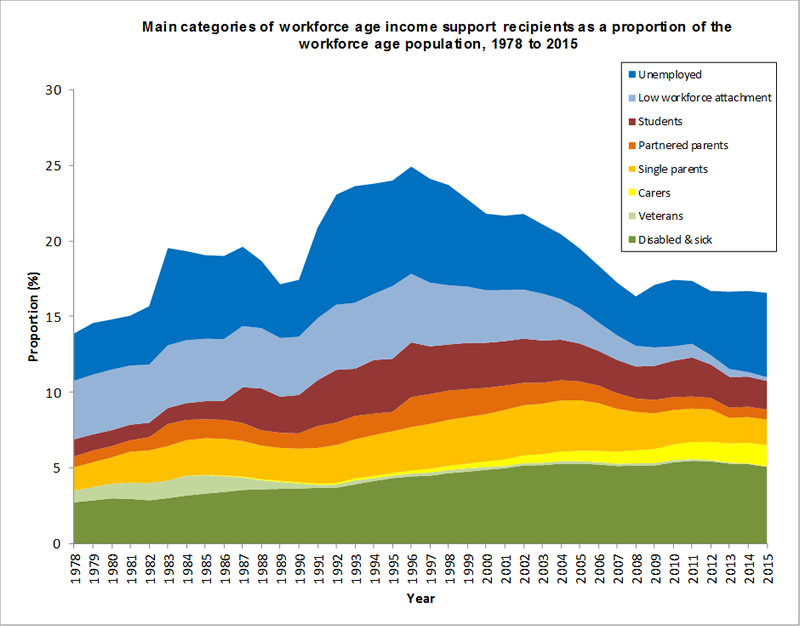Posted 26/08/2016 by Carol Ey
Relatively low unemployment rates and the effect of a series of changes to eligibility for some payments has seen the proportion of the working age population receiving income support continue to decline, since peaking at over 25% in 1994.
The chart below shows the proportion of the working age population receiving income support payments as at 30 June in each year from 1978 to 2015.

Source: Parliamentary Library estimates based on Department of Social Services and Australian Bureau of Statistics data
Historically, income support receipt among the working age population is closely related to trends in the unemployment rate. The spike in receipt in the early 1980s largely reflected a growth in the unemployment rate from 7.3% in June 1981 to 10.6% in 1983. Similarly, the rapid growth in income support receipt in the early 1990s was associated with an increase in the unemployment rate from 6.7% in 1989 to over 10% during 1992 and 1993. This was followed by a long period of decline as unemployment fell to 4.5% in 2008, and then a slight increase as unemployment rose following the Global Financial Crisis (GFC). However in recent years, while the unemployment rate has continued to increase slightly, the proportion of the working age receiving income support payments has actually fallen.
As noted in an earlier FlagPost, reforms of the 1990s and 2006 saw a number of low workforce attachment payments, that is, payments which did not require recipients to be actively looking for work or studying, closed to new entrants. These included payment of the Age Pension to women under 65, and payments to partners, the mature aged and some classes of widows. The reforms, combined with a declining unemployment rate, saw a dramatic decline in receipt of income support for those aged 16 to 64 until 2008. As noted above, the GFC produced a slight reversal of this trend, but since 2010 the decline has continued, albeit slowly, despite rising unemployment. As at June 2015, 16.6% of the working age population was in receipt of income support, almost back to the 2008 level of 16.3%.
Not only has the total proportion of the population receiving income support declined since the high of 1994, but the composition of the payment types has also changed substantially in recent years. In addition to the reduction in those receiving low workforce attachment payments, the proportion receiving parenting payments has declined from a high of 5% in 1998 to 2.4% in 2015. This probably reflects changes to eligibility for these payments for those with school aged children.
While the proportion of the population receiving most other payment types declined from the mid 1990s until 2008, receipt of payments for the sick and people with a disability had continued to rise. However this trend has now reversed with the proportion declining slightly since 2011, from 5.5% to 5.1% in 2015, most likely reflecting the impact of a series of reforms seeking to tighten eligibility for the main payment in this area, the Disability Support Pension (DSP).
In 1993, at the height of the recession, 7.7% of the working age population were in receipt of unemployment benefits. This proportion steadily declined to 3.3% in 2008, before the impact of the GFC saw it rise to 4.4% in 2010. However, while the overall level of income support dependence among the working age population has declined since then, the proportion of the population on unemployment payments has continued to rise, reaching 5.6% in June 2015. It is probable that changes to tighten eligibility for other payments such as parenting payments and DSP have at least partially driven this increase.
However the most dramatic increase in income support reliance for the working age population has been among carers. The proportion of the working age population receiving Carer Payment has doubled since 2005, from 0.7% to 1.4%. Ageing of the population overall, with a consequential increase in the need for carers may be a factor in this increase. It is also possible that changes to the eligibility for the Age Pension and other payments for mature-aged women have meant that those who are caring for elderly partners are now accessing this payment.
Overall it would appear that previous reforms of the income support system, coupled with a stable unemployment rate, have been successful in reducing dependence on welfare for the working age population.